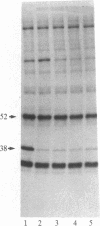Abstract
The polypeptide chain initiation factor 2 (eIF-2) binds phospholipid (PL) and becomes a potent inhibitor of translation in hemin-supplemented reticulocyte lysates. This binding is markedly reduced by prior treatment of eIF-2 with N-ethylmaleimide. Although PL is probably bound by all three eIF-2 subunits, our results suggest that the inhibitory molecule is produced by binding to the alpha subunit because, functionally, PL binding has the same effect on eIF-2 as alpha-subunit phosphorylation. This is suggested by the following findings. (i) Like translational inhibition due to heme deficiency, inhibition by small amounts of the eIF-2 X PL complex is prevented by small amounts of the GDP exchange factor (GEF). (ii) In the presence of Mg2+, the GEF-catalyzed formation of a ternary complex (eIF-2 X GTP X Met-tRNAi in which Met-tRNAi is the eukaryotic initiator methionyl tRNA) is inhibited by eIF-2 X PL just as well as by eIF-2 alpha-subunit phosphorylation. (iii) Also in the presence of Mg2+, GEF is unable to catalyze the exchange of free GDP with eIF-2 X PL-bound GDP, as it fails to catalyze the exchange of free GDP with GDP that is bound to alpha-subunit-phosphorylated eIF-2. These observations suggest that, like alpha-subunit-phosphorylated eIF-2, eIF-2 X PL traps GEF in a nondissociable eIF-2 X PL X GEF complex, whereby GEF is no longer able to catalyze ternary complex formation and initiation is inhibited.
Full text
PDF




Images in this article
Selected References
These references are in PubMed. This may not be the complete list of references from this article.
- Clemens M. J., Pain V. M., Wong S. T., Henshaw E. C. Phosphorylation inhibits guanine nucleotide exchange on eukaryotic initiation factor 2. Nature. 1982 Mar 4;296(5852):93–95. doi: 10.1038/296093a0. [DOI] [PubMed] [Google Scholar]
- De Haro C., De Herreros A. G., Ochoa S. Activation of the heme-stabilized translational inhibitor of reticulocyte lysates by calcium ions and phospholipid. Proc Natl Acad Sci U S A. 1983 Nov;80(22):6843–6847. doi: 10.1073/pnas.80.22.6843. [DOI] [PMC free article] [PubMed] [Google Scholar]
- Matts R. L., Levin D. H., London I. M. Effect of phosphorylation of the alpha-subunit of eukaryotic initiation factor 2 on the function of reversing factor in the initiation of protein synthesis. Proc Natl Acad Sci U S A. 1983 May;80(9):2559–2563. doi: 10.1073/pnas.80.9.2559. [DOI] [PMC free article] [PubMed] [Google Scholar]
- Matts R. L., London I. M. The regulation of initiation of protein synthesis by phosphorylation of eIF-2(alpha) and the role of reversing factor in the recycling of eIF-2. J Biol Chem. 1984 Jun 10;259(11):6708–6711. [PubMed] [Google Scholar]
- Ochoa S. Regulation of protein synthesis initiation in eucaryotes. Arch Biochem Biophys. 1983 Jun;223(2):325–349. doi: 10.1016/0003-9861(83)90598-2. [DOI] [PubMed] [Google Scholar]
- Siekierka J., Datta A., Mauser L., Ochoa S. Initiation of protein synthesis in eukaryotes. Nature of ternary complex dissociation factor. J Biol Chem. 1982 Apr 25;257(8):4162–4165. [PubMed] [Google Scholar]
- Siekierka J., Manne V., Ochoa S. Mechanism of translational control by partial phosphorylation of the alpha subunit of eukaryotic initiation factor 2. Proc Natl Acad Sci U S A. 1984 Jan;81(2):352–356. doi: 10.1073/pnas.81.2.352. [DOI] [PMC free article] [PubMed] [Google Scholar]
- Siekierka J., Mauser L., Ochoa S. Mechanism of polypeptide chain initiation in eukaryotes and its control by phosphorylation of the alpha subunit of initiation factor 2. Proc Natl Acad Sci U S A. 1982 Apr;79(8):2537–2540. doi: 10.1073/pnas.79.8.2537. [DOI] [PMC free article] [PubMed] [Google Scholar]
- Siekierka J., Mitsui K. I., Ochoa S. Mode of action of the heme-controlled translational inhibitor: relationship of eukaryotic initiation factor 2-stimulating protein to translation restoring factor. Proc Natl Acad Sci U S A. 1981 Jan;78(1):220–223. doi: 10.1073/pnas.78.1.220. [DOI] [PMC free article] [PubMed] [Google Scholar]
- Thomas N. S., Matts R. L., Petryshyn R., London I. M. Distribution of reversing factor in reticulocyte lysates during active protein synthesis and on inhibition by heme deprivation or double-stranded RNA. Proc Natl Acad Sci U S A. 1984 Nov;81(22):6998–7002. doi: 10.1073/pnas.81.22.6998. [DOI] [PMC free article] [PubMed] [Google Scholar]
- de Haro C., Ochoa S. Further studies on the mode of action of the heme-controlled translational inhibitor. Proc Natl Acad Sci U S A. 1979 Apr;76(4):1741–1745. doi: 10.1073/pnas.76.4.1741. [DOI] [PMC free article] [PubMed] [Google Scholar]




